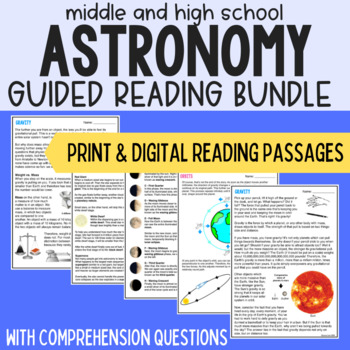The Universe & Space Science Reading Comprehension Bundle
- Zip
- Google Apps™
- Easel Activity

What educators are saying
Products in this Bundle (8)
showing 1-5 of 8 products
Also included in
- Is lesson planning just too much on top of teaching on top of grading on top of classroom management on top of *ahem* living your life? Get all the guidance you need to teach a comprehensive, no-prep astronomy unit either in person, hybrid, or virtual with my all inclusive unit bundle! This unit wiPrice $50.00Original Price $73.00Save $23.00
- Do your students struggle with scientific literacy? Do you find yourself at a loss for how to promote vocabulary retention? Are waning attention spans becoming a larger and larger problem in your classroom from year to year? If you answered yes to any of those questions then this bundle is for you.IPrice $288.00Original Price $411.50Save $123.50
- Is lesson planning just too much on top of teaching on top of grading on top of classroom management on top of *ahem* living your life? Get all the guidance you need to teach a full year earth science course either in person, hybrid, or virtual with my all inclusive curriculum bundle! This curriculPrice $314.00Original Price $448.74Save $134.74
Description
Do your students struggle with scientific literacy? Do you find yourself at a loss for how to promote vocabulary retention? Are waning attention spans becoming a larger and larger problem in your classroom from year to year? If you answered yes to any of those questions then this bundle is for you.
I believe that teaching literacy is the job of every teacher, not just the heroes in English and Language Arts. And the only way we can help our students improve is by modeling and giving them chances to practice. Read out loud together, annotate, and spark classroom discussion today!
I created this line of guided reading resources to help teachers, parents, and students by providing a detailed yet easy to read (avg. reading level: grades 6-8) reference on a variety of topics. The questions that accompany the text are designed to be rigorous and require students to predict, reflect, connect, and think critically about the information being presented.
Let's get our students reading, writing, and integrating vocabulary with this resource that is compatible with multiple styles of teaching. Your purchase includes both PDF and digital copies that are perfect for pre-reading, homework and review, or even sending to absent students.
GUIDED READING RESOURCES INCLUDED:
- Moon Phases
- Orbits
- Gravity
- Seasons
- Life Cycle of Stars
- Star Systems & Galaxies
- Tides & Eclipses
- The Big Bang
Who is this bundle for?
This bundle can be used by classroom teachers, tutors, and parents of students in grades 6-9. It comprehensively covers the mentioned topics, and includes several comprehension and extension questions that will lock in learning.
How Can I Use these Resources?
- Emergency Sub Plans
- An independent work station in a set of stations
- Flipped Classroom pre-reading
- Whole or small group opportunity to model and teach Close Reading strategies and annotation
- Differentiation – Assign this reading as reteaching for students who have yet to show mastery.
- Homework
- Creation of Independent Work Packet for students who are not able to be present for direct instruction.
- Extension activity for early finishers or for students who show a special interest in the topic
- Use as a square on a Choice Board
- Interactive Notebooks: Print 2 pages in one and cut apart. Glue mini pages into notebooks with room for annotations on the side
- Interactive Notebooks: Print entire PDF as a mini booklet and add to notebooks using these simple instructions.
What's Included?
Each resource in this bundle comes as a printable PDF file in color with answer key. On page 2 of the resources you will find a link to a student friendly Google Slide version of this file. You will be able to copy these file and use it with Google Classroom or any other paperless initiative.
Please take a look at the preview files to see more of this resource.
What's Next?
If you enjoy this resource, consider checking out some of my other guided reading bundles:
- Life Science Guided Reading Bundle
- Physical Science Guided Reading Bundle
- Earth Science Guided Reading Bundle
More questions?
Email me at laneyleeteaches@gmail.com
-------------------------------------------------------------------------------------------------------------------------------
To stay updated on sales and new products, please follow my store:
Connect and chat with me!






